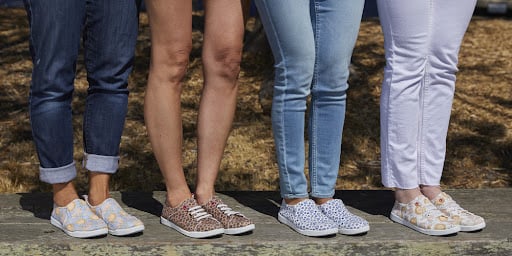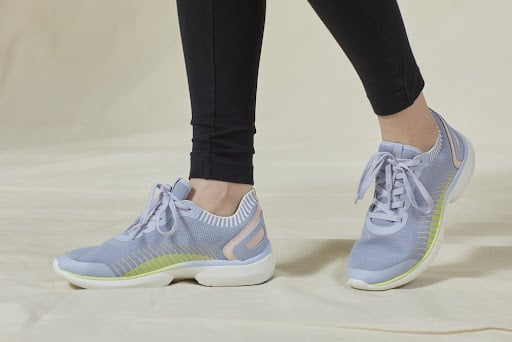Maybe you’ve got circulation problems and are looking for a solution. You might be an athlete who heard from your conditioning coach that compression socks (or even compression stockings) can improve your endurance. Perhaps you’re pregnant and are trying to get rid of that pesky swelling around your feet and ankles.
But first, you want to know if it’s true–do compression socks work?
The quick answer? Yes—and you’ve come to the right place to learn more. So, pull up your compression socks and find out why people wear them, how they work, and some benefits you can expect from adding them to your sock drawer.
How Do Compression Socks Work?
Let’s start by putting compression socks under the microscope to find exactly what they are and how they are different from a regular sock:
- Compression socks are long, stretchy socks that typically end just below the knee.
- Some are longer or shorter, depending on your purpose for wearing them.
- Others are called “sleeves” because they only cover your leg or part of your foot, leaving your toes free.
- When worn, they fit snugly, and as the name would suggest, they gently hug your legs.
Sure, that makes sense, but why do compression socks work?
As they’re softly squeezing, the added pressure allows your blood vessels to work more efficiently. Your arteries relax, the blood flows more easily, and your veins get a little help pushing blood back into your heart, which is good for people with poor circulation.1 With improved blood flow, you’re less likely to have blood pooling in your legs and ankles, which means you’re also decreasing your chances of uncomfortable swelling in the lower extremities. On a side note, wearing compression socks does not raise your blood pressure.
Why Do People Wear Them?
There are a number of reasons people might wear compression socks (and similarly other compression garments). For some, it’s a personal choice, while for others, it’s a method their doctor has suggested to improve their health.
They’re frequently used to treat edema, which occurs when small blood vessels in the body leak fluid, causing that area to look puffy or swollen.2 It’s often seen in the lower extremities, such as the legs, ankles, and feet.
Edema can happen for a number of reasons and often affect people who:
- Are pregnant
- Have varicose veins
- Stand or sit for an extended period of time
- Have circulation issues
- Have consumed a large amount of sodium
In addition to the swelling, people with foot problems can also benefit from compression socks. Not only can they decrease pain caused by plantar fasciitis by increasing blood flow to the feet, but they can also provide added support and pressure to the arch of your foot, whether you’re on your feet or off of them.3 24-hour support at your service.
Benefits of Compression Socks
By now, you’ve probably caught on that one of the main advantages of compression socks is that they’re excellent at improving blood circulation. A better blood flow in your lower body has a myriad of benefits, including:
Reducing Puffiness and Swelling
Most people who have suffered from edema will tell you how uncomfortable it can be. The skin sometimes appears stretched, your feet feel heavy, and your shoes are too tight or even unwearable.
Compression socks can be a miracle worker if you have edema. If you wear your compression socks as prescribed, they can greatly decrease the puffiness in your feet, ankles, and legs because of the increased blood flow they offer.
Depending on the severity of your particular case, your doctor can prescribe the compression level that’s right for you so that you get the best results. There are multiple levels of compression socks available for many uses, including but not limited to edema. The most common levels of compression include:4
- 15 to 20 mmHg – This is ideal for traveling, flying, or if you find yourself standing for too long. This level of compression can be purchased over the counter at many retailers.
- 20 to 30 mmHg – A medical-grade class I compression sock, it must be prescribed by a doctor. It’s most commonly used for varicose veins or for use after surgeries.
- 30 to 40 mmHg – This is a class II medical-grade compression sock and is often used to avoid blood clots or for people with lymphedema
Aiding in Muscle Recovery
If you’re an athlete, you may have heard your athletic trainer remind you to “RICE it” more than once to avoid a potential injury. RICE stands for rest, ice, compression, and elevation, and it’s sage advice.
Compression socks can really lend a helping hand with the compression aspect of RICE. Many trainers will suggest wearing them while exercising to reduce muscle fatigue and to speed up the recovery process after a workout.5
Providing Higher Quality Sleep
If you’ve ever had sleep apnea or restless leg syndrome, you’re probably well aware of the negative impacts they can have on your ability to sleep. Although compression socks are typically worn during the day, they sometimes come in handy at night since increasing blood circulation is one method physicians often recommend to improve restless legs. With better blood flow, you may find less discomfort at night, offering you a better night’s sleep.
Treating Varicose Veins
Varicose veins are veins that have become twisted and enlarged near the top of the skin, often caused by increased pressure.6 Doctors sometimes recommend compression socks to help circulate blood more efficiently through your leg and help alleviate the pressure. This can allow the veins to shrink down to a more reasonable size and shape.
Providing Relief for Serious Health Conditions
Compression socks are used for more chronic ailments as well. People with the following conditions often use compression socks to lessen their symptoms:
- Postural Orthostatic Tachycardia Syndrome (POTS) – Using compression socks can help people with POTS improve fatigue, muscle pain, dizziness, lightheadedness, and more.
- Neuropathy – Because of the increased blood flow that occurs with the use of compression socks, they may be able to decrease the tingly and prickly feeling associated with neuropathy.
Making Long Periods of Standing or Sitting More Comfortable
Compression socks can be useful for people who sit or stand throughout the day due to their line of work. Sitting or standing in the same position for too long sometimes lets blood pool in the lower extremities, which can cause swelling and discomfort. If you work in any of the following sectors and have noticed any pain or inflammation, compression socks might make a difference in your day-to-day responsibilities:
- Air travel workers
- Medical staff
- Supply chain workers
- Office staff
- Truck drivers
Avoiding Athletic Injuries and Increasing Performance
Imagine you’ve sustained a minor injury while training. Perhaps now you cannot perform at peak levels like you were doing previously. You’ve got to take measures to ensure you’re healing quickly so you can get back on your feet. Time is of the essence.
But what if you could take your safety into your own hands and lessen the likelihood of an injury altogether? It’s a fairly simple concept, really. If you can avoid an injury, you have a higher likelihood of performing better when it counts. Wearing compression socks may help you because they can help reduce the amount of stress placed on your muscles while you’re out there giving it your all.
Can Compression Socks and Orthotics Work Together?
You might already be familiar with orthotics—the shoe inserts your podiatrist gives to improve your foot-related issues. They’re often used for the following:
- Arch support – If you have flat feet, orthotics can help provide the correct amount of support to have better overall stability.
- Realignment – Orthotics can aid in aligning your feet to avoid other issues like flat feet, hammertoe, and bunions.
What if the compression socks and orthotics could work together? If you’ve ever wondered what it would be like if they worked in tandem, then you’re on the right track!
You can definitely wear your inserts or orthotic footwear while you’re out and about to offer support on the go. When you get home, kick back and relax—and keep the healing momentum strong—by pulling on your compression socks. They pick up right where your shoes are left off so that your feet get better blood flow from the gentle, comforting squeezes (courtesy of your socks).
Vionic makes inserts more accessible for all by providing the comforts of orthotics built conveniently right into our shoes. From sneakers and boots to wedges and sandals, comfort and style meet in the middle to give you just the right amount of support and relief—leaving your feet to revel in the buoyant bliss they deserve.
Team Up With Vionic to Provide Your Feet With the Support They Crave
If you’re suffering from a foot-related problem, why not do everything you can to make yourself more comfortable? Wearing compression socks can be an excellent method to improve your ailment, but why not consider giving your feet twice the love?
Improving your foot health can improve your quality of life, and happy feet can certainly make life more enjoyable. Invest in a pair of Vionic shoes that can help jumpstart your recovery process. Aside from sneakers, we also have training, running, and walking shoes for women and men. If you want more support, we also have recovery sandals, performance shoes and orthopedic sandals for men and women. We also sell other foot accessories, such as arch support inserts.
Whether you’re headed to work, going out for dinner with friends, or relaxing at home, we’ve concocted the perfect blend of support and sophistication so you can find the pair that’s right for you.
Reviewed by:
Dr. Jacqueline Sutera is a surgically trained doctor of podiatric medicine specializing in the prevention and treatment of foot pathology. She graduated from Fordham University with a Bachelor of Science degree in Biology and Philosophy. She later attended the New York College of Podiatric Medicine where she earned the degree of Doctor of Podiatric Medicine (DPM).
Dr. Sutera received her postgraduate residency training at the busy level-one trauma center at Jamaica Hospital in Queens, NY and Brookdale Hospital in Brooklyn, NY. During her time there, she served as chief surgical resident and received and completed training in all aspects of podiatric medicine and surgery. Dr. Sutera is Board Certified in Foot Surgery and is a Fellow of the American College of Foot & Ankle Surgeons.
She is also a proud member and spokesperson for the American Podiatric Medical Association and the New York State Podiatric Medical Society. As one of NYC’s premier podiatric physicians, she is a caring, conscientious and extremely personable doctor who prides herself on being holistic in her approach to foot care. Where other doctors treat feet only locally, she has a unique gift of being able to link some foot problems to other underlying conditions taking place in the body.
Sources:
- “How to Choose and Use Compression Stockings.” WebMD. 28 July, 2021. https://www.webmd.com/dvt/choose-compression-stockings
- “Edema.” Mayo Clinic. https://www.mayoclinic.org/diseases-conditions/edema/symptoms-causes/syc-20366493
- “Compression Socks and Plantar Fasciitis.” Sole Science. 13 July. 2019. https://www.solescience.ca/compression-socks-plantar-fasciitis/
- “What Level of Compression Socks Do I Need? (A Guide to mmHg Pressure Levels).” ComproGear. Updated 8 January, 2022. https://comprogear.com/what-level-of-compression-socks-do-i-need/
- “10 unexpected benefits of compression socks.” VIM & VIGR. 16 March, 2022. https://vimvigr.com/blogs/our-blog/4-unexpected-benefits-of-wearing-compression-socks
- “Varicose Veins.” Johns Hopkins Medicine. https://www.hopkinsmedicine.org/health/conditions-and-diseases/varicose-veins





Leave a Reply